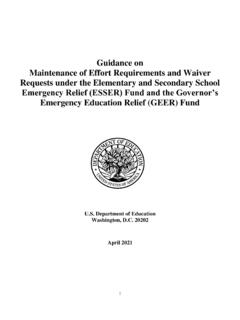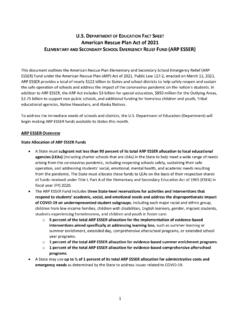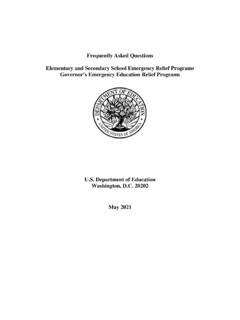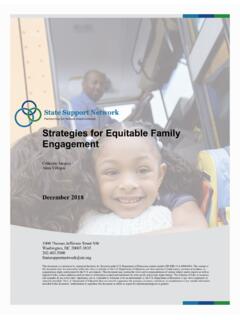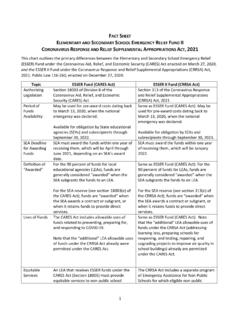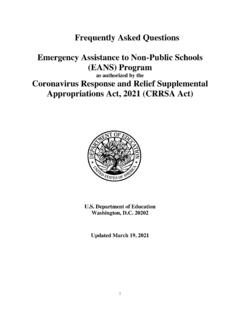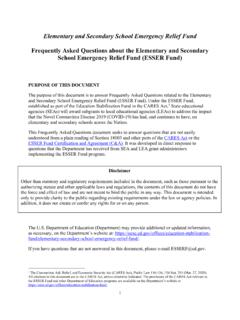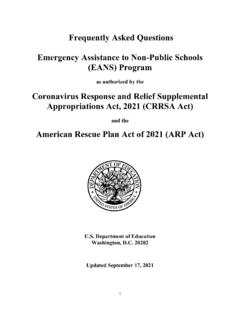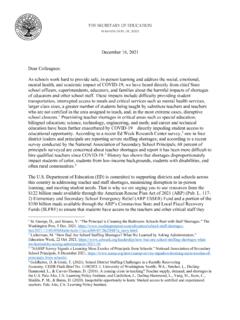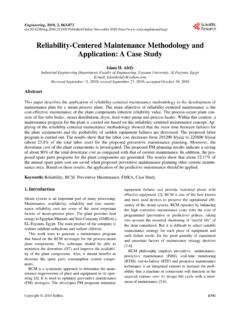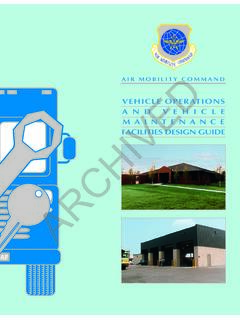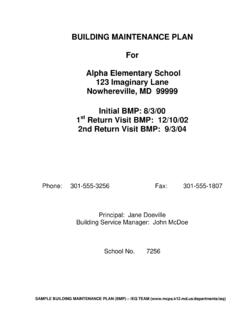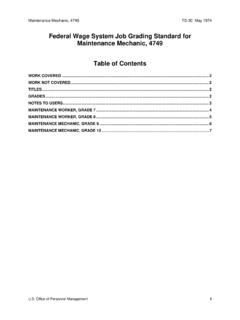Transcription of Frequently Asked Questions American Rescue Plan Elementary ...
1 Frequently Asked Questions American Rescue Plan Elementary and Secondary School Emergency Relief (ESSER) Program maintenance of Equity Requirements Department of Education Washington, 20202 Updated July 26, 2022 (Updated Appendix A) 2 Department of Education Frequently Asked Questions American Rescue Plan Elementary and Secondary School Emergency Relief (ESSER) Program maintenance of Equity Requirements Section 2004 of the American Rescue Plan Act of 2021 (ARP Act) includes new maintenance of equity (MOEquity) provisions that are a condition for a State educational agency (SEA) and local educational agency (LEA) to receive funds under the Elementary and Secondary School Emergency Relief (ARP ESSER) Fund. These provisions are central to ensuring that essential resources are meeting the needs of students who have been subject to longstanding opportunity gaps in our education system. These student groups have also experienced the greatest impact from the Coronavirus Disease 2019 (COVID-19) pandemic.
2 maintenance of equity provisions will help ensure that schools and LEAs serving large proportions of historically underserved groups of students including students from low-income families, students of color, English learners, students with disabilities, and students experiencing homelessness receive an equitable share of State and local funds as the Nation continues to respond to the COVID-19 pandemic s impact. These schools and LEAs historically have been under-funded and are more reliant on State funding than are schools and LEAs with lower concentrations of underserved students. Accordingly, if State or local funds are cut, the maintenance of equity provisions ensure that LEAs and schools serving a large share of students from low-income backgrounds do not experience a disproportionate share of such cuts in fiscal years (FYs) 2022 and 2023, and that the highest poverty LEAs do not receive a decrease in State funding below their FY 2019 level.
3 The provisions in ARP ESSER that target funding to LEAs with concentrations of students from low-income families have the potential to be rendered ineffective without the safeguards of the maintenance of equity requirements. By protecting these LEAs from disproportionate funding cuts, and all cuts for the highest poverty LEAs compared to their FY 2019 level, maintenance of equity helps to ensure that vital resources are available to mitigate the impact that the pandemic has had, and continues to have, on underserved students, including addressing students social, emotional, mental health, and academic needs. In addition, the maintenance of equity provisions ensure that each LEA safeguards its high-poverty schools from disproportionate cuts to funding and staffing so that students from low-income families in each LEA are not disproportionately impacted by State and local cuts to vital resources. This document is intended to provide guidance to SEAs and LEAs as they implement these important new requirements.
4 In addition, Appendix A includes information on baseline and initial maintenance of equity data that each SEA must submit by July 30, 2021 for FY 2022. Other than statutory requirements included in the document, the contents of the guidance do not have the force and effect of law and are not meant to bind the public in any way. This document is intended only to provide clarity to the public regarding existing requirements under the law or agency policies. In addition, it does not create or confer any right for or on any person. If you have Questions that are not answered in this document, please email and include MOEquity in the subject line. 3 maintenance of Equity Frequently Asked Questions Background 1. What is maintenance of equity? maintenance of Equity (MOEquity) is a set of new fiscal equity requirements in ARP ESSER. Specifically, MOEquity ensures the following: An SEA does not disproportionately reduce per-pupil State funding to high-need LEAs.
5 An SEA does not reduce per-pupil State funding to the highest-poverty LEAs below their FY 2019 level. An LEA does not disproportionately reduce State and local per-pupil funding in high-poverty schools. An LEA does not disproportionately reduce the number of full-time-equivalent (FTE) staff per-pupil in high-poverty schools. 2. How is MOEquity different from maintenance of effort (MOE)? Both requirements are intended to help ensure that States and LEAs do not use ARP ESSER funds to reduce State and local financial support for education, which would have the effect of mitigating or even eliminating the purpose of the ARP ESSER program, which is to provide the extra, supplemental funding needed to maintain teaching and learning during and after the pandemic, safely reopen schools and maintain operations for full-time, in-person instruction as soon as possible, and address the effects of lost instructional time on students social, emotional, mental health, and academic needs.
6 The MOE requirements in section 2004(a) of the ARP Act ensure that a State maintains overall financial support for Elementary and secondary education and for higher education. The MOEquity requirements in section 2004(b) and (c) ensure that, if funding reductions are necessary, each SEA and LEA does not disproportionately reduce per-pupil funding for education in those LEAs and schools in the State with the highest percentages of students from low-income families. Moreover, in the absolute highest-poverty LEAs, an SEA may not reduce per-pupil allocations of State funds below the LEAs FY 2019 level. For further guidance on maintenance of effort requirements, see the Department s April 2021 Guidance on maintenance of Effort and Waiver Requests under the Elementary and Secondary School Emergency Relief Fund and the Governors Emergency Education Relief Fund. 3. Which entities must comply with the MOEquity requirements? Each SEA and LEA that receives ARP ESSER funds must comply with the applicable MOEquity requirements in section 2004(b) or (c) of the ARP Act, respectively, as a condition of receiving those funds.
7 4. In which fiscal years must an SEA and LEA maintain equity? An SEA and LEA must maintain equity in each of FYs 2022 and 2023. 4 5. What MOEquity requirements apply to an SEA? Under section 2004(b) of the ARP Act, as a condition of receiving ARP ESSER funds, an SEA may not, in each of FY 2022 or 2023 Reduce the per-pupil amount of State funding for any high-need LEA (see Question 10) by an amount that exceeds the overall per-pupil reduction in State funding, if any, across all LEAs in the State. Reduce the per-pupil amount of State funding for any highest-poverty LEA (see Question 11) below the per-pupil amount the SEA provided to such LEA in FY 2019. 6. What MOEquity requirements apply to an LEA? Under section 2004(c) of the ARP Act, as a condition of receiving ARP ESSER funds, an LEA may not, in each of FY 2022 or 2023 Reduce combined State and local per-pupil funding for any high-poverty school (see Question 23) by an amount that exceeds the total reduction, if any, of combined State and local per-pupil funding for all schools in the LEA.
8 Reduce the number of FTE staff per-pupil in any high-poverty school by an amount that exceeds the total reduction, if any, of FTE staff per-pupil in all schools in the LEA. 7. What does fiscal year mean when determining MOEquity? For purposes of determining MOEquity, an SEA and its LEAs may use either the applicable State fiscal year or Federal fiscal year. In either case, the applicable school year for FY 2022 would be school year (SY) 2021-2022 and the applicable school year for FY 2023 would be SY 2022-2023. Federal Fiscal Year State Fiscal Year (example) School Year FY 2022 October 1, 2021 - September 30, 2022 July 1, 2021-June 30, 2022 2021-2022 FY 2023 October 1, 2022 - September 30, 2023 July 1, 2022-June 30, 2023 2022-2023 8. At what point in a fiscal year does an SEA or LEA determine whether it maintained equity? Each SEA and LEA must officially determine whether it maintained equity once it has final appropriated and allocated amounts that are available for current expenditures for each LEA or school, respectively, for the applicable fiscal year.
9 ( See Questions 17 and 26.) However, to ensure compliance, the SEA and LEA should verify whether it w ill maintain equity prior to making final State and local allocations to LEAs and schools, respectively, so that the SEA or LEA is able to modify its State and local allocations to high-need and highest-poverty LEAs and to high-poverty schools if equity is not achieved. With the passage of the American Rescue Plan in March, we recognize that some States may have already completed their appropriation process for FY 2022 before MOEquity provisions were enacted. The Department expects all SEAs to comply with MOEquity requirements and will work with States to provide technical assistance and address any unique needs during this initial implementation period. It is important to emphasize that no State should delay awarding and allocating ARP ESSER funds to its LEAs until local MOEquity data are available for high-poverty schools.
10 To the contrary, ARP ESSER 5 funds should be allocated to LEAs expeditiously as their availability is essential to the broader goal of advancing educational equity. State maintenance of Equity 9. What are the State level MOEquity requirements? Each SEA must separately maintain fiscal equity for high-need LEAs and highest-poverty LEAs as a condition of receiving ARP ESSER funds. Under section 2004(b)(1) of the ARP Act, for any LEA identified by the SEA as a high-need LEA, the SEA may not, in FY 2022 or 2023, reduce State funding, calculated on a per-pupil basis, by an amount that exceeds the overall per-pupil reduction in State funds, if any, across all LEAs in the State for such fiscal year. Under section 2004(b)(2) of the ARP Act, for any LEA identified by the SEA as a highest-poverty LEA, the SEA may not, in FY 2022 or 2023, reduce State funding, calculated on a per-pupil basis, below the amount the SEA provided per-pupil to such LEA in FY 2019.
